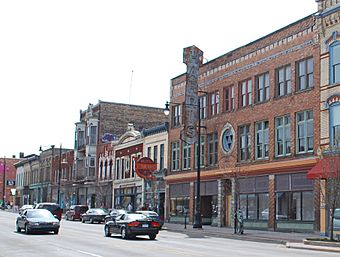Heartside facts for kids
Quick facts for kids |
|
|
Heartside Historic District
|
|
 |
|
| Location | Roughly bounded by Division and Ionia Aves and Cherry and Louis Sts., Grand Rapids, Michigan |
|---|---|
| Architectural style | Late Victorian, Commercial Italianate, and Richardsonian Romanesque |
| NRHP reference No. | 82002844 |
| Added to NRHP | March 2, 1982 |
Heartside is a cool neighborhood located right next to downtown Grand Rapids, Michigan. It's a growing area known for its awesome art scene! You can find fun restaurants, a park with a playground and a splash-pad (perfect for hot days!), and even a new farmer's market where you can get fresh food.
Heartside's Past
Long ago, Heartside was a wet, marshy area near the Grand River. Around the 1850s, as Grand Rapids started to grow, people began building simple homes here. Many new families, especially from Ireland, moved into the area. By the 1870s, Heartside had become a busy neighborhood with small, cozy houses.
In 1870, the Grand Rapids and Indiana Railroad built a train line right through Heartside. They also built a train station at what is now Ionia Avenue and Oakes Street. This made it super easy for people and goods to travel! Because of the railroad, Heartside quickly grew with new businesses and factories. By 1900, the area was full of shops, factories, apartment buildings, and hotels.
Heartside Historic District
The Heartside Historic District is a special part of the bigger Heartside neighborhood. It's where many of the oldest and most important buildings are located. A historic district is an area recognized for its unique history and architecture.
This district covers six full city blocks and parts of two others. You can find these buildings along Ionia, Commerce, and Division Avenues, stretching from Cherry Street to Fulton and Louis Street. There are 62 buildings in the district, and 55 of them are considered historically important.
Most of these buildings are made of brick or sandstone. They are usually two to six stories tall. Many of them were built before 1929. They show off cool styles like Italianate, Late Victorian, and Richardsonian Romanesque architecture.



